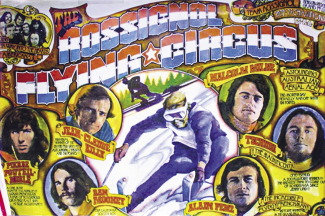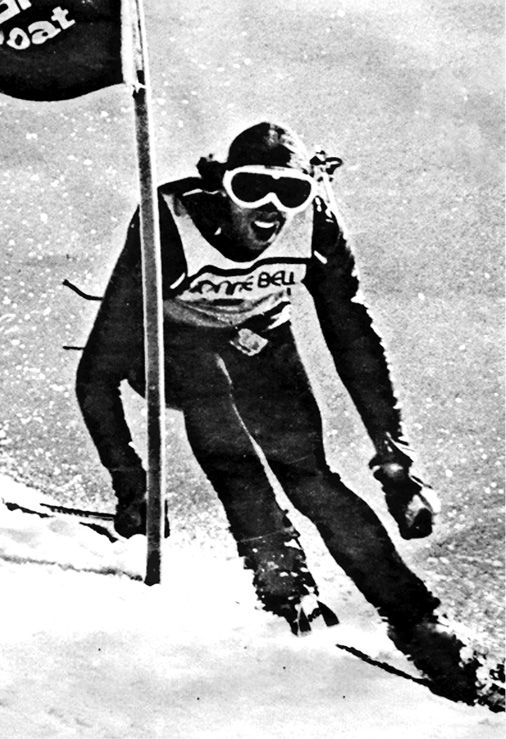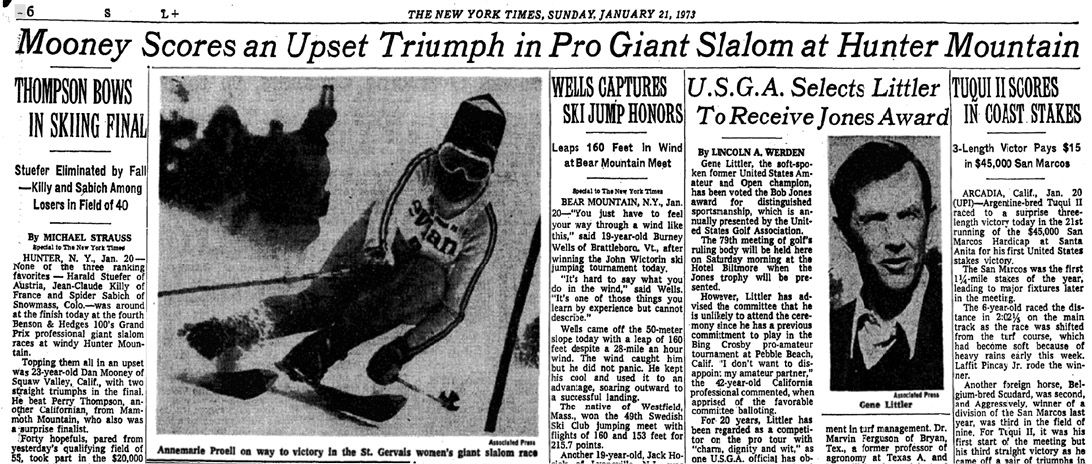Moondog and the Champ

In 1972, Dan Mooney dropped off the U.S. Ski Team. Nine months later, he raced head to head with Jean-Claude Killy—and won.
In the spring of 1972 I was 21 years old. A couple of years earlier I had fought my way onto the U.S. Ski Team, with my sights on the ’72 Winter Olympics. I was hurt and frustrated at subsequently not making the cut for Sapporo. Then in March, I was disqualified in the first run of the slalom at the national championships at Mt. Bachelor. Before the race had even ended, I caught a ride back to the condo and sat alone, sipping beer while contemplating my future. I couldn’t expect the team to carry me four more years until the 1976 Olympics. I had the sinking feeling that I was at the end of my ski-racing career.
I thumbed through the latest issue of Ski Racing magazine, not paying particular attention to its contents. What caught my eye was a full-page ad promoting the last two World Pro Skiing Tour races of the season, to be held the next week in Steamboat Springs and Vail, Colorado.
Pro ski racing, created by former U.S. Ski Team Coach Bob Beattie, was in only its third season. “Beats” had already recruited some Olympians for the tour, starting with Billy Kidd, who became the 1970 World Pro Champion, and Spider Sabich, pro champion in 1971 and ’72. After Sapporo, Beats recruited Hank Kashiwa and Tyler Palmer. I knew Tyler well.
I phoned Beattie, and he invited me to try to qualify in Steamboat. But first I needed to get to Colorado, and I only had about 10 dollars to my name. I figured it was going to take $300 to travel there, pay the entry fee and leave me a little for food and a beer. The only person I could ask for that type of a loan was my mother, a war bride who was born and raised in Germany. She expected me to go back to college if I left the ski team. She said no at first, but I promised that if pro racing didn’t work out, I would make a beeline to Denver and register for spring quarter. She was silent. I held my breath. Then she said, “Ach du liebe, Danny, you are the wild one in the family.” She agreed, on condition I pay her back and keep the promise.

Early the next morning Ken Corrock drove me to the bus station. I arrived in Steamboat on a Wednesday afternoon and got signed up for qualifying on Thursday morning. In pro racing, you didn’t get to the money round until you were down to 16 racers, and there were more than 100 skiers trying to make it to the group of 16.
Then my skiing just clicked. I was on fire. The first round, I had the fastest time. I won in the afternoon round, too. People noticed, including Beattie. He told me after the second qualifying round that I was looking really good. I started to think this pro racing thing might just work.
I aced the Friday qualifiers and was in the money round after four qualifying races. Ski racing was fun again. I was hanging with my friend Tyler, and life seemed grand.
In Saturday’s giant slalom I made it to the quarterfinals. In Sunday’s slalom I got to the semifinals. In two days I made about $1,500, which would be about $12,000 in 2023. I went to Vail the next week and made another $500. $2,000 in two weeks! I was in heaven—I had done what I wanted to do, made a name for myself at the pro level and had momentum going into the next winter. I had a good chance at sponsorship for the 1972–73 season.
I repaid my mom the $300 and never went back to college. Tyler and I flew first class to the Bahamas for two weeks.
I went home to Squaw Valley for the summer. My old friend Warren “Hoot” Gibson, coach of the junior ski team there, had put together an amazing summer training program, and I wanted to work out with his kids while looking for sponsorship, starting with K2, my supplier on the ski team.
Brutal training
Warren’s program was intense. Every morning at 7 a.m. we cycled from Squaw Valley to Truckee High School, about 30 miles round-trip. In the afternoon, we did a five-mile run on the high school track, then on Monday and Wednesday hit the weight room, doing did 10 reps at each of the 10 stations. On Tuesday and Thursday we did sprints: 10 440-yard laps (four miles in all), followed by 10 220s, with a one-minute rest period between laps. If you didn’t complete your lap in the allotted time, you had to do a bonus lap. On “Black Friday” we did both weights and sprints.
I protested that the program was overkill. Warren put his arm over my shoulder and said, “I hear that Jean-Claude Killy is going to join the pro tour this year. Do you want to get in the starting gate against him and not be in the best physical condition possible?”
“What, me race Killy, head to head? That will never happen.”
“But what if it does?”
He had me. I did the 30-mile cycles, the five-mile runs, the 440s, the 220s and the weights. The pain was unreal. It was a long summer and fall.
In early June I made my call to Gordy Eaton, director of racing for K2. He listened politely and then explained that it was still too early in the year for a decision but that he would throw my hat in the ring. I agreed to call back in July.
That month I went to Aspen for a World Pro Skiing press conference, and Tyler was there. I talked him into coming with me to Squaw to join Warren’s program. When he got there and saw the enormity of it, he, too, protested. But Warren had the gift of gab and had Tyler on board in less than five minutes.
I called K2 again in July and got the same answer. They strung me along until October, then told me that Spider Sabich would be their only racer on the pro circuit that year. I was furious. If I had known that in June, I’d have had time to line something up. Now, with less than two months until the first race, it was too late. I would have to go in as an independent and hope to have some good early results. Then maybe some sponsor would pick me up.
Over the summer, we had learned that Rossignol was putting together a team of skiers from different countries for the pro tour. They needed an American because the tour was an American invention and we did all of our competitions in North America. Beattie had arranged for Tyler to be the American.
At the end of October, with less than four weeks to go before the first race, Beattie called to tell Tyler that Lange had come up with a much better offer for him. When Tyler told me this, I felt a glimmer of hope. “Rossignol will have to replace you with another American,” I said.
Without hesitation, I phoned Rossignol and got through to the director of racing, Gerard Rubaud. I had met him once, and when I introduced myself now, he was nice enough to tell me he knew me. I didn’t waste any time and explained to him that Tyler had just signed with Lange, which means he needed an American. “With three weeks till the first race, I am calling to let you know I’m your guy,” I said.
Gerard responded, “This is all news to me. Let me make a few phone calls, and I will call you back.”
When he did, Gerard offered to pay my expenses to train with the team for two weeks in Vail and then to compete in the first two races. If I finished third or better in either of those races, he’d offer a contract to keep me on the team for the season. If I failed, I’d be on my own.
In Vail, plucked by Rossignol from the depths of despair, I trained with Alain Penz and Pierre Pouteil-Noble, from France; Otto Tschudi, from Norway; and Malcolm Milne, from Australia. I knew Otto pretty well, but no one else. I tried to stay out of the way and keep a low profile. I was nervous but hung in there, and by the time we left for Aspen, for the first race, I felt pretty good.
No Luck in Aspen
At Aspen, I had no problem making it into the round of 16. But in my first heat I walked out of a binding and disqualified. One chance gone, three to go. The next day in the slalom I qualified but fell in the first round. I couldn’t afford mistakes like that. Aspen was a bust, and I left frustrated but not defeated. (Ed: It wasn’t a glorious weekend for Killy or Sabich, either. They both struggled to qualify. Killy, unsponsored and racing on borrowed K2 skis, then lost the first round of GS to Harald Stuefer; on Rossignols, he fell in the quarterfinals of slalom. Sabich crashed in the first round of GS and lost to Ken Corrock in the first round of slalom. Stuefer won the GS, and Hugo Nindl the slalom. Penz took second in both races.)
In Vail the next weekend, I skied out of the course in the round of 16 on Saturday. I had one chance left, the slalom on Sunday. At least Killy, now skiing for Rossignol, got to the finals in GS, where he lost to Stuefer.
This was it, Sunday morning. I could feel the pressure before I even got out of bed. I kept saying to myself, “You can’t make mistakes today, you have to ski perfect, you have to go after it, you have to concentrate.” I made it into the semifinals with four racers left: myself, Tyler, Sabich, and Killy. I was matched against Tyler, and Sabich against Killy. The losers would go on to race for third and fourth place, the winners for first and second. Tyler, a slalom specialist, had won a World Cup slalom in Kitzbühel the previous winter. He grew up in New Hampshire, where all they do is practice slalom on boilerplate ice. I skied well, but he took me and moved on to the finals.
Last Chance at Vail
Spider beat Killy. And there I was, paired against the greatest ski racer in history. He owned three World Championship gold medals, three Olympic gold medals and six World Cup titles. He was my idol. I was going to get only one chance, and slalom was not my strong event.
I headed to the lift for the ride to the start. Tyler appeared out of nowhere to share the chair. “Moondog,” he said, “You can beat him. He doesn’t know who you are. He doesn’t know you ran 10 million 440s this summer. He is in your house. You need to beat him out of the start, go into the first jump ahead of him or neck and neck. You do that, and you’ve got a shot at the deal.” He made me a believer.
Some 5,000 fans lined the course and the finish area. Beattie was announcing through loudspeakers set up along the course, and he was good at working up a crowd.
When that gate opened, I shot out like a cannon, getting an early lead. Through the early gates, I could feel Killy’s presence right on me. We hit the first jump side by side, and as we neared the second jump, he took a slight lead. We hit the second jump and sprinted to the finish. He took the first run by 2/10th of a second, not a huge lead. Going back up the lift, Tyler pumped me up again.
“See, he’s not so bad. 2/10th of a second. You’ve got him! He’s nervous, he didn’t expect you to be so close! Nail him out of the start again, get to the first jump and turn on the afterburners.”
For the second run, we switched courses, and in the starting gate I pounded my ski poles in the snow, taking deep breaths. I looked over at Killy. To my surprise, he was just standing there looking at me, so I stopped fussing and stared back. This went on for about 15 seconds, and—call me crazy—I swear I saw fear in his eyes. At that moment I said, loudly, “Okay, let’s do this!” I think the starter may have been quietly rooting for me because he said, “Mr. Mooney has indicated he would like to proceed with the second run. Do we have a clear course? Racers ready?”
When those gates opened, it was clear that Killy had no intention of letting me beat him. And me? Well, I had something to prove. We raced like men possessed: hitting gates, taking chances. We hit the first jump neck and neck. Through the middle of the course it was more of a slugfest than a ski race. Nearing the second jump, Killy faltered slightly and I gained a slight lead. At the jump I led by about half a ski length, just enough so I could no longer see him in my line of sight. I landed and focused on the finish, five gates to go. I put everything I had into it, and more.
I crossed the finish line and looked over my shoulder to see where he was. No Killy. I came to a stop. The finish area was eerily quiet—even Beattie was silent. I looked up the hill and there between the second jump and the finish was Killy, standing on the hill and putting his ski on. Then Beattie came on the PA: “Ladies and gentlemen, I have the official ruling from the chief of course. Jean-Claude Killy landed wide off the second jump, hooked a tip and missed a gate, officially disqualifying. The Moondog has done it. He has upset Killy and taken third place!”
Tyler was the first one to me. He wrapped his arms around me and slapped my back: “You did it, Moondog, you pulled it off! You son of a bitch! When did you become a slalom skier?”
A crowd gathered. I had press and TV people asking me all these questions. How did I do it? What was my strategy? I was speechless. Then, working his way through the crowd, coming towards, me was Jean-Claude. People stepped aside to give him room. He put out his hand to shake mine and said, “Congratulations, Dan. Today you skied like a true champion. You deserved to win.” I think I said thank you, or at least lipped it.
At five o’clock, I met Gerard at his hotel room. He handed me a contract from Rossignol. I thought of the condo in Bend where this roller coaster adventure had begun. Then I picked up the pen. I had only one thought: “Moondog, you’re going to the Show.” 

Dan Mooney finished the season as the eighth-place prizewinner on the pro tour, earning $10,100. Killy trained hard over Christmas break and came back with a Team Rossignol contract to win the season championship, and $28,625 in prizes.
